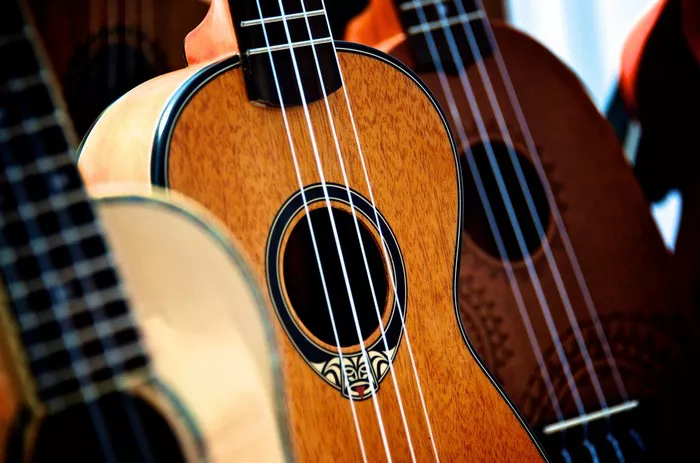The soprano ukulele, renowned for its diminutive size and delightful sound, stands as a quintessential member of the ukulele family. Originating from Portugal and gaining popularity in Hawaii during the late 19th century, the ukulele has since become a symbol of tropical relaxation and musical joy worldwide. Among its various sizes, including concert, tenor, and baritone, the soprano ukulele holds a special place due to its compact dimensions and distinct, bright timbre.
One of the defining characteristics of the soprano ukulele is its standard tuning: G-C-E-A. This tuning scheme, known as re-entrant tuning, contributes to the ukulele’s unique sound profile, allowing for easy chord formations and melodic playing.
Tuning Methods for Soprano Ukulele
1. By Ear with a Reference Note
Tuning a soprano ukulele by ear with a reference note is a traditional method that requires careful attention to pitch and sound. Here’s a step-by-step guide:
Prepare a Reference Note: Begin by obtaining a middle C reference note from a piano, keyboard, tuning fork, or any other reliable source. This note will serve as a point of comparison for tuning the ukulele strings.
Loosen the Strings: Before starting the tuning process, ensure that all the strings are loosened to a point where they are lower in pitch than the desired tightness. This initial step prevents over-tightening and potential string breakage.
Tune Each String: Pluck each string individually and adjust its tension until its pitch matches the corresponding note. The strings should be tuned in the following order: G, C, E, A. Compare the sound of each string to the reference note, making subtle adjustments as necessary to achieve the correct pitch.
2. Using a Tuner
Modern technology has made tuning the soprano ukulele more accessible with the use of electronic tuners. Follow these steps to tune your ukulele using a clip-on tuner:
Attach the Tuner: Clip the electronic tuner onto the headstock of the ukulele, ensuring a secure fit. The tuner’s display should be easily visible for convenient monitoring.
Pluck Each String: Begin by plucking the G string and observe the tuner’s display. The tuner will detect the pitch of the string and indicate whether it is sharp, flat, or in tune. Adjust the tension of the string accordingly until it aligns with the desired pitch.
Repeat for Remaining Strings: Continue plucking and tuning each string in sequence: G, C, E, A. Follow the tuner’s guidance to achieve accurate tuning for every string.
String Order and Notes
It’s essential to familiarize yourself with the string order and corresponding notes on the soprano ukulele:
- G String: G4
- C String: C4
- E String: E4
- A String: A4
These notes represent the pitch of each string when tuned to standard G-C-E-A tuning.
Why High G String?
One of the defining characteristics of the soprano ukulele is its high G string, which sets it apart from other ukulele sizes. Unlike linear tuning, where the strings are tuned sequentially from low to high pitch, re-entrant tuning features a high G string tuned to a higher octave than expected. This unique configuration contributes to the ukulele’s bright and lively sound, enhancing its ability to cut through ensembles and evoke a cheerful atmosphere.
The high G string also facilitates the execution of traditional ukulele techniques, such as fingerpicking and strumming, by providing easy access to melodic lines and chord embellishments. Its re-entrant tuning adds a playful character to the soprano ukulele’s sound, making it well-suited for both solo performance and accompaniment in various musical genres.
Additional Information
Tuning Variations: While standard G-C-E-A tuning is the most common configuration for soprano ukuleles, some players may prefer alternative tunings for specific musical purposes. One popular variation is low G tuning, where the G string is tuned down an octave to produce a deeper, more resonant sound. Experimenting with different tunings can expand the sonic possibilities of the soprano ukulele and inspire creative exploration.
Fretboard Notes: Understanding the layout of the ukulele fretboard is essential for navigating chords, scales, and melodies. Each fret represents a semitone change in pitch, allowing players to produce a wide range of musical tones. Beginners can benefit from memorizing the names and locations of the notes on the fretboard, which facilitates learning and improvisation.
Scale Length: The scale length of a soprano ukulele typically ranges from around 13 to 14 inches, measured from the nut to the saddle. This relatively short scale length contributes to the ukulele’s bright and lively tone, making it a popular choice for recreational players and professional musicians alike.
Conclusion
In conclusion, mastering the art of tuning a soprano ukulele is essential for unlocking its full musical potential. Whether tuning by ear with a reference note or utilizing a clip-on tuner, the process requires patience, precision, and a keen ear for pitch. By understanding the principles of re-entrant tuning and exploring various tuning variations, ukulele enthusiasts can embark on a journey of musical discovery with this beloved instrument.


